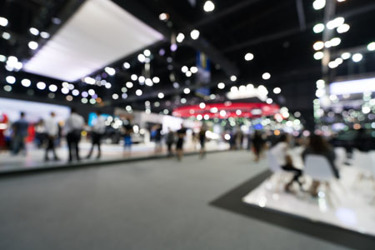How To Maximize Your Medtech Booth At Trade Shows: During The Trade Show
By Cesare Ferrari, TRB Chemedica International

Welcome to the second article of my three-part series on trade show management for medtech companies. In the first article, I’ve covered the complete pre-show planning, including defining the objectives, deciding on the trade show, and the important pre-show marketing activities. In this article, I will discuss all the key activities you should do at the trade show. You can train your team on what to say and how to behave by using these next tips, which I structure into the “do’s and don’ts.”
Do’s
Produce a booth schedule. Prepare and share among the staff a booth schedule, including all prearranged meetings. This simple tool allows each staffer working on the booth to know exactly what is happening.
For example, it helps inform a customer or prospect when a specific person will be available. It also allows everyone to set up important company meetings outside their booth "work" schedule.
Break the ice. As soon as visitors walk in, welcome them. If you are busy, excuse yourself for a moment and let them know you'll be with them shortly.
You've probably had a time when you visited a store and had to make an extra effort to get the salesperson's attention because they were either on the phone or doing something else. You'll agree that such experiences are unpleasant. Therefore, booth reps have to stay fully present.
Your goal is to build a rapport so you can ask qualifying questions. Typically, I'll say something like: “I noticed you looked into our booth. Is there something that caught your eye?” Or, “thank you for stopping at... what caught your attention?”
Also, you need to avoid closed-end questions like “Can I help you?” because the answer can be a clear “No!”
Prequalify prospects. When talking to visitors, you need to find out what their needs are and if they are potentially interested in your product now or in the future. Asking these questions helps you prequalify them in line with your objectives and collect contact information to pass on to the designated team member.
For example, here are questions you can ask if you are looking for a commercial partner in a new country and want to know about:
- Market knowledge: How many years have you worked in XYZ in the ABC sector?
- Complementary products: What other products are you currently selling in our segment?
- Customer relationships: How many active customers do you currently have in the market?
- Goals and priorities: Which kind of product and relationship are you looking for?
Also, pay attention to red flags such as lack of transparency, low market knowledge, connections to competitor products, incompatible selling style, and differing values.
The tough concept for many people working at exhibitions is that not everyone at the trade show is interested in your product and not everyone stopping at your booth is a prospect.
So, when you see that you are not conversing with a viable prospect, politely thank the person for stopping and let them go. If the prospect is prequalified, you must find a mutual agreement on the next step after the trade show.
Some useful sentences to politely send away disqualified prospects are:
- “It really sounds like we don't have products in our portfolio fitting your need. Thanks for stopping by.”
- “Name of the person, I think we could talk all day, but I know how hard it is to properly visit the exhibition in one or two days, so we'll let you go on your way. Thanks for visiting XYZ.”
- “Thank you for visiting XYZ. Unfortunately, your country is not on our priority list. Please leave me your contact details and I will reconnect with you in the future if our priorities change.”
Use videos. In today's booths, it is almost mandatory to have a video. The reason is that videos attract visitors, help to visualize product information and benefits, and keep people entertained while they wait their turn. In medtech, it is important to show how the product is used and what the key features are. 3D animations and hands-on stations are good tools for this purpose – and they provide a very appealing visitor experience.
When you prequalify some prospects, the discussion at the booth could be a very good opportunity to build trust and sell the company, not just the product. Prospects need evidence that you and your company are good possible partners. This is also why you should follow up with your prospects.
Engage with passing people. This is essential, especially if you are a small player in the periphery of the exhibition. Through the show, you will engage with several people that may not be interested in your offer. It is very common to take several saying “no” and few saying “yes.” However, you need to think of the “no’s” as steps to getting a “yes” and understand that rejection is part of the game.
Visit the exhibition. During the trade show, find time to check out what the other exhibitors are doing. This includes direct competitors, market leaders, and product launches. Then put yourself in the attendee's shoes and look through the exhibits to see what grabs your attention.
Practice active listening. It's essential to have sound knowledge of your products and company. However, avoid talking too much during the exhibition.
The key is to focus on gathering information that will allow you to address how your company can solve the "customer’s" problems and make positive improvements.
Of course, there will be times when you'll need to engage in very detailed discussions with your prospects, but this should not be the norm. Learn to listen more than you talk.
Check in with your team. To evaluate the congress with your teammates, openly ask what is working. What isn't? How can we improve on performance? Allow your staff to contribute to the discussion. This will help to make mid-course corrections and keep the team motivated for the rest of the day.
Don'ts
Do not sit in your booth, work on your computer, or continuously use your phone. Behaviors like these project negative messages such as you are uninterested, busy, bored, etc. To look approachable, do something else that engages with attendees.
Sitting on a stool is not bad either because it will be easier to make eye contact than sitting on a chair behind a table. Whatever option you choose, the goal is to always look approachable.
Do not eat at the booth. This is an essential suggestion because this signal is worse than the previous one. Again, ask yourself, “What kind of message am I sending?” “What if my drink spills and gets the booth dirty?”
Also, do you think someone feels at ease when you are eating, and he/she is not?
If you must have lunch and snacks, it's better to leave the booth and go somewhere else.
Do not cluster with colleagues. When you're in a group discussing with colleagues, it is almost impossible for a visitor to break in and start a conversation. Think how you feel at a party where you do not know anyone and want to join a group conversation. It can be very difficult for most people.
So, avoid cluster discussions and remember that most visitors are more comfortable having a one-on-one conversation with you.
Do not complain to visitors. Everyone knows that exhibitions are tough and tiring; therefore, there is no point in describing the stress to visitors.
Follow the simple rule that says attendees can complain about the trade show, but exhibitors cannot. Your job as an exhibitor is to be sympathetic to attendees' complaints.
Do not copy other exhibitors. Believe it or not, most of the people working at medical trade shows had poor training or no training at all in how to perform at a show. Moreover, a lot of companies manage this important marketing tool in an amateurish way. So, they watch what everyone else is doing and copy what they think makes others’ booths successful.
Before copying, please go back to your objectives and what you decided to do, and examine whether what the other company is doing aligns with your goals. Ask yourself questions like: “Is this the right tool to get the attention of our target customer? Does this have to do with what we want to be remembered for? Is this the right way to reach our objectives?”
Do not overestimate entertainment. Some form of entertainment, if in line with your objectives, can help to attract visitors and increase booth traffic. However, consider the fundamentals of good exhibition management before making this move.
I remember an event held a few years ago where a cartoonist caused a booth to be crowded with doctors waiting to get their cartoons done. After the congress, I met several doctors who had hung their cartoons in their offices; however, no one could remember the company's or the product's name.
Again, the question should always be: Is this entertainment a way to reach your goals?
Do not look threatening. Your booth must look open, inviting and nonthreatening to visitors. This is where your staff's behavior and nonverbal communications are critical.
I always remember when a colleague shared a few pictures of a booth where the staff looked more like security guards and bouncers than a welcoming sales team. For example, two tall guys standing with crossed arms, side by side at the imaginary entrance of the booth, are unlikely to invite visitors into the booth with their disposition.
Do not use booth babes. Although this practice is becoming very rare in our industry, a few people still think some booth babes are good marketing tools.
I would be cautious about building a business relationship with a company that uses women this way.
Although booth babes can drive attention to your booth, consider that potential prospects can feel embarrassed, disturbed, or distracted. None of these sentiments sets a good mood for a professional discussion.
Practicing these tips and tricks will increase your performance and make your trade show presence very professional. In my next article, I will share practical advice on how to effectively manage your post-show activities.
About The Author:
 Cesare Ferrari is area director CSEA at TRB Chemedica International. He is a sales and marketing leader with an extensive international experience in healthcare (pharma and medtech). He holds a master's in pharmaceutical chemistry from the University of Milan and an exMBA from SDA Bocconi School of Management — Milan. You can find him on LinkedIn.
Cesare Ferrari is area director CSEA at TRB Chemedica International. He is a sales and marketing leader with an extensive international experience in healthcare (pharma and medtech). He holds a master's in pharmaceutical chemistry from the University of Milan and an exMBA from SDA Bocconi School of Management — Milan. You can find him on LinkedIn.
*The views and opinions expressed in this article are those of the author and do not necessarily reflect the official position, opinions, or thoughts of TRB Chemedica International.
